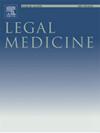醋酸溶液用于干尸皮肤组织再水化的评价
IF 1.4
4区 医学
Q3 MEDICINE, LEGAL
引用次数: 0
摘要
与自溶或腐烂的组织相比,在木乃伊化的组织中保留了骨骼肌横向条纹等组织学特征,为组织学分析提供了组织学或法医信息。然而,由于其硬度,处理干燥组织进行组织学检查是困难的。此外,在脱水过程中,组织结构可能发生改变,导致染色外观的改变。为了克服这些问题,诸如桑迪森溶液之类的补水溶液已在古组织学和法医环境中得到应用。在本研究中,我们介绍了另一种方法,利用醋酸对干燥的组织进行补水,用于法医痕量证据分析。我们通过干燥动物皮肤切片组织来模拟犯罪现场调查中发现的碎片组织标本。与未补液处理的标本相比,乙酸处理有效地改善了苏木精-伊红染色和结缔组织染色的结果。值得注意的是,即使用醋酸溶液处理2小时,也能充分改善染色结果,这表明醋酸溶液可以用于快速分析破碎和干燥的组织,用于刑事调查。本文章由计算机程序翻译,如有差异,请以英文原文为准。
Evaluation of acetic acid solution for rehydration of mummified skin tissues
Histological characteristics such as transverse striation of skeletal muscle are preserved in mummified tissues compared with autolyzed or putrefied tissues, providing histological or forensic information upon histological analysis. However, processing dried tissue for histological examination is difficult due to its hardness. In addition, the histological architecture may be altered during the dehydration process, leading to alternation of the staining appearance. To overcome these problems, rehydration solutions such as Sandison’s solution have been utilized in both paleohistological and forensic contexts. In this study, we introduce another procedure utilizing acetic acid to rehydrate dried tissue for forensic trace evidence analysis. We prepared mock mummified tissue specimens by drying sliced animal skin tissues to simulate fragmented tissue specimens found at crime scene investigations. Acetic acid treatment improved the staining results efficiently for both hematoxylin-eosin staining and connective tissue staining compared with specimens without rehydration treatments. Notably, even 2-h treatment with acetic acid solution sufficiently improved the staining results, suggesting that acetic acid solution can be used to rapidly analyze fragmented and dried tissues for criminal investigations.
求助全文
通过发布文献求助,成功后即可免费获取论文全文。
去求助
来源期刊

Legal Medicine
Nursing-Issues, Ethics and Legal Aspects
CiteScore
2.80
自引率
6.70%
发文量
119
审稿时长
7.9 weeks
期刊介绍:
Legal Medicine provides an international forum for the publication of original articles, reviews and correspondence on subjects that cover practical and theoretical areas of interest relating to the wide range of legal medicine.
Subjects covered include forensic pathology, toxicology, odontology, anthropology, criminalistics, immunochemistry, hemogenetics and forensic aspects of biological science with emphasis on DNA analysis and molecular biology. Submissions dealing with medicolegal problems such as malpractice, insurance, child abuse or ethics in medical practice are also acceptable.
 求助内容:
求助内容: 应助结果提醒方式:
应助结果提醒方式:


